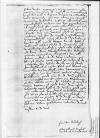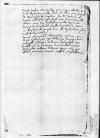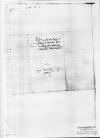Mulieri huic opera mea non defuit, sed absque tamen magno negotio vicit, quandoquidem adversarius, cum constitutum diem non obierit, causa cecidit. Qui si etiam affuisset, nihil eum profecturum fuisse confido. In portu iam navigare viduam credo. Cui si quid forte adhuc exhibebitur negotii, libenter pro virili mea sum adfuturus, causam enim iustam habere videtur. Data est etiam a me opera, ut semotis arbitris colloqui posset cum ⌊reverendissimo domino⌋, dixit abunde omnia satis longo tempore. Admonebitur ⌊reverendissimus dominus Vladislaviensis⌋ litteris
s(erenissimae) or s(acrae)⌈s(erenissimae)s(erenissimae) or s(acrae)⌉
⌊maiestatis regiae⌋ officii sui, sed et in ⌊comitiis regni⌋ futura est mentio de hoc fidei negotio. Ad quae legati proficiscuntur: dominus ⌊castellanus Lublinensis⌋ et dominus ⌊Andreas Czarnckowski⌋, scholasticus Cracoviensis. Nos hic hiemabimus, fortasse et aestivabimus. Utinam vero ne iterum hiememus et aestivemus, nam lotum gustavimus. Dominus ⌊castellanus Posnaniensis⌋ quae attulit, plena sunt horroris. Dominus ⌊castellanus Cracoviensis⌋ miserat suum quendam, ut exploraret, qui sit status serenissimae ⌊reginae Isabellae⌋. Is attulit ab ea litteras ad ⌊herum⌋ suum scriptas, sed manus illius non est, agnita tamen est manus pueri, qui servit eius secretario domino Petro Porembski. Est in ⌊Lyppa⌋ et hanc tantum et unam quandam aliam arcem  FG, Chart. A 381, f. 20v habere dicitur magnaque rerum omnium affici penuria.
FG, Chart. A 381, f. 20v habere dicitur magnaque rerum omnium affici penuria.
Cum servo domini ⌊castellani Cracoviensis⌋ profectus erat a regina Hungariae cubicularius eius Sienovitz, qui iam etiam pervenisse ⌊Cracoviam⌋ dicebatur, in horas adventus eius expectabatur. Undecim iam dies expectatur et missi sunt hac nocte cubicularii, qui eum in itinere quaerant, num decumbat aeger alicubi. Hic cum venerit, afferet omnia certiora.
Est hic dominus ⌊Laszki castellanus Praementensis⌋, cuius ⌊frater dominus palatinus⌋ dicitur esse apud ⌊regem Romanorum⌋ et phtisi laborare. Alius ⌊frater dominus Ioannes⌋ esse ⌊Vratislaviae⌋ ferebatur atque inde litteras ad ⌊reverendissimum dominum Vladislaviensem⌋ dedisse, quarum exemplum, si reperire tam cito potero, mittam Reverendissimae Dominationi Vestrae. Ceterum qui hic est frater eius, negat, ut audio, se de eo quicquam scire. Utrum ita sit, an se forte scire dissimulat, nescio. Sunt, qui dicant eum ⌊Cracoviae⌋ visum fuisse inter canonicos in processionem euntem. Brevi certius aliquid habebimus, quod cum Reverendissima Dominatione Vestra postea communicabo. Cui hoc nuper per ⌊Mauricium⌋ scribere oblitus eram, dominus ⌊Costcka⌋ et apud
s(erenissimam) or s(acram)⌈s(erenissimam)s(erenissimam) or s(acram)⌉
⌊maiestatem regiam⌋, et apud ⌊reverendissimum dominum⌋ certe diligenter excusasse Reverendissimam Dominationem Vestram, quod ipsa non modo non impedierit contributionem, sed ut ea fieret, auctor semper fuerit.
Commendo me gratiae Reverendissimae Dominationis Vestrae ac Deum precor, ut eam diu servet incolumem et felicem.
 FG, Chart. A 381, f. 21r
FG, Chart. A 381, f. 21r
Venit tandem Sienovitz. Quae nova attulit, Reverendissimae Dominationi Vestrae descripta mitto, una et illa, quae scripsit dominus ⌊Biecensis⌋ de ⌊caesare⌋. De domino ⌊Ioanne a Lasco⌋ allatum est fuisse eum ⌊Cracoviae⌋, sed clam; non ire infitias, quod uxorem duxerit; sacerdotia velle repetere. Nunc in ⌊Kiesmarck⌋ profectum ad visendum ⌊fratrem⌋ valetudinarium.
Venit plenipotens adversarii viduae, quem dicit ipsum per aegritudinem venire non potuisse, sed ego viduam discessisse iam arbitror, cui ⌊Caunam⌋ una cum novis descriptis mittam litteras. Spero eum, qui hodie primum venit, nihil profecturum.
 FG, Chart. A 381, f. 20v habere dicitur magnaque rerum omnium affici penuria.
FG, Chart. A 381, f. 20v habere dicitur magnaque rerum omnium affici penuria.



